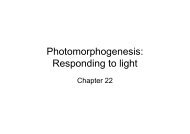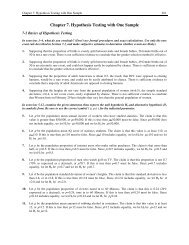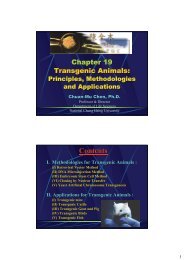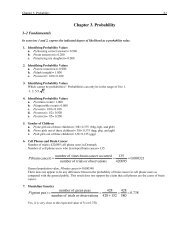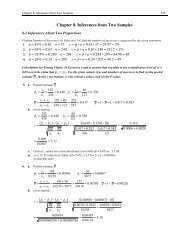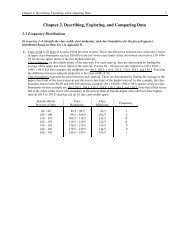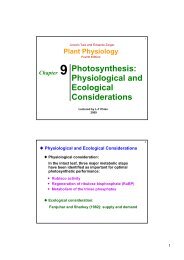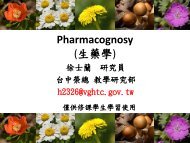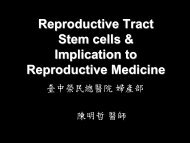isoform-like proteins in marine euryhaline milkfish (Chanos
isoform-like proteins in marine euryhaline milkfish (Chanos
isoform-like proteins in marine euryhaline milkfish (Chanos
Create successful ePaper yourself
Turn your PDF publications into a flip-book with our unique Google optimized e-Paper software.
528C.-H. TANG ET AL.Fig. 6. The summary of Na 1 /K 1 -ATPase (NKA) a3-<strong>isoform</strong><strong>in</strong> gills of <strong>milkfish</strong> sampled at a series of different timesafter transfer from SW to HSW or FW. (A) Representativeimmunoblots of NKA a3-<strong>isoform</strong> probed with a polyclonalantibody revealed s<strong>in</strong>gle immunoreactive bands at approximately105 kDa. (B) The relative prote<strong>in</strong> abundance follow<strong>in</strong>gtransfer from SW to HSW <strong>in</strong>dicated that NKA a3-<strong>isoform</strong>decreased significantly after 12 hr post-transfer. On the otherhand, follow<strong>in</strong>g transfer from SW to FW, changes <strong>in</strong> therelative prote<strong>in</strong> abundance of NKA a3-<strong>isoform</strong> levels decl<strong>in</strong>edgradually dur<strong>in</strong>g 48 hr post-transfer and significantly decreasedat 96 and 168 hr post-transfer. Values were mean7SEM (n 5 6). The asterisks <strong>in</strong>dicated significant differences(Po0.05) compared with the 0 hr us<strong>in</strong>g Dunnett’s testfollow<strong>in</strong>g a one-way ANOVA. M, marker; SW, seawater;HSW, hypersal<strong>in</strong>e water.SW-acclimated <strong>milkfish</strong> (L<strong>in</strong> and Lee, 2005).Therefore, alteration of NKA activity <strong>in</strong> gills offish follow<strong>in</strong>g sal<strong>in</strong>ity changes may result fromdifferent NKA <strong>isoform</strong>s.There is accumulat<strong>in</strong>g evidence to presume thatNKA a-<strong>isoform</strong>s may change <strong>in</strong> teleosts to copewith the environmental fluctuations, e.g., sal<strong>in</strong>ityor temperature. The mRNA expression patterns ofgill NKA a1a and a1b exam<strong>in</strong>ed <strong>in</strong> varioussalmonid species were found to express differentially<strong>in</strong> FW- and SW-acclimated <strong>in</strong>dividuals(Richards et al., 2003; Bystriansky et al., 2006,2007a,b; Nilsen et al., 2007). Changes <strong>in</strong> mRNAexpression are often assumed to parallel changes <strong>in</strong>prote<strong>in</strong> abundance. The lack of correlationbetween mRNA and prote<strong>in</strong> of branchial NKAa-<strong>isoform</strong>s was reported (Morrison et al., 2006). Thislack of correlation between mRNA and <strong>prote<strong>in</strong>s</strong>uggested the correlation with posttranscriptionalregulation (Scott et al., 2004). This study,therefore, <strong>in</strong>vestigates the effect of environmentalsal<strong>in</strong>ity on the prote<strong>in</strong> expression of branchialNKA a-<strong>isoform</strong>s-<strong>like</strong> <strong>prote<strong>in</strong>s</strong> <strong>in</strong> <strong>milkfish</strong>.The am<strong>in</strong>o acid identities of <strong>in</strong>dividual <strong>isoform</strong>sacross species are higher than the identities ofdifferent <strong>isoform</strong>s with<strong>in</strong> one species (Blanco andMercer, 1998). Therefore, the heterologous antibodiesto NKA a-<strong>isoform</strong>s (polyclonal antibodiesdirected aga<strong>in</strong>st the rat a-specific <strong>isoform</strong>s) wereused <strong>in</strong> Atlantic salmon (Salmo salar) (D’Cottaet al., 2000) as well as <strong>in</strong> this study. Among the<strong>isoform</strong>-specific heterologous antibodies used <strong>in</strong><strong>milkfish</strong>, mouse monoclonal antibody a6F to theavian NKA a1-<strong>isoform</strong> and goat polyclonal antibodysc-16052 to human NKA a3-<strong>isoform</strong> had beenapplied <strong>in</strong> teleosts previously (tilapia, Oreochromismossambicus; Lee et al., 1998; Antarctic fish,Trematomus bernacchii; Brauer et al., 2005). Thisstudy identified three NKA a-<strong>isoform</strong>-<strong>like</strong> <strong>prote<strong>in</strong>s</strong><strong>in</strong> <strong>milkfish</strong> gills with these <strong>isoform</strong>-specific antibodiesby immunoblott<strong>in</strong>g analysis (Figs. 1A, 2A,and 3A). Three NKA a-<strong>isoform</strong>-<strong>like</strong> <strong>prote<strong>in</strong>s</strong> werealso found <strong>in</strong> the gills of Antarctic fish (Guynnet al., 2002), while only a1 anda3 werereported<strong>in</strong>tilapia gills (Lee et al., 1998; Feng et al., 2002). Theimmunoblots of <strong>milkfish</strong> gill lysates probed witheach <strong>isoform</strong>-specific antibody revealed s<strong>in</strong>gle immunoreactivebands at approximately 105–115 kDa(Figs. 1A, 2A, and 3A), similar to those recognized<strong>in</strong> tilapia (Lee et al., 1998) and Antarctic fish(Guynn et al., 2002; Brauer et al., 2005).This study revealed that the SW-acclimatedgroup was significantly higher than the FW- orHSW-acclimated groups <strong>in</strong> the levels of NKAa1- and a3-<strong>like</strong> <strong>prote<strong>in</strong>s</strong> (Figs. 1 and 3). Expressionpattern of NKA a2-<strong>like</strong> prote<strong>in</strong> <strong>in</strong> the gills were notsal<strong>in</strong>ity-dependent (Fig. 2B). It was suggested thata1- and a3-<strong>like</strong> <strong>prote<strong>in</strong>s</strong> might play the role forosmo- or ionoregulation but a2-<strong>like</strong> prote<strong>in</strong> probablyperformed the other physiological function.The aff<strong>in</strong>ity of gill NKA for sodium <strong>in</strong>creasedsignificantly <strong>in</strong> warm-acclimated Antarctic teleost(T. bernacchii; Morrison et al., 2006) that isopposite to <strong>milkfish</strong>, which has lower sodiumaff<strong>in</strong>ity <strong>in</strong> SW than FW (L<strong>in</strong> and Lee, 2005).Upregulation of gill a1- and a2-<strong>like</strong> <strong>prote<strong>in</strong>s</strong><strong>in</strong>fluenced sodium aff<strong>in</strong>ities and fulfilled some ofthe requirements for the subtly moderated enzymebehaviors (e.g., elevated NKA activity) <strong>in</strong> warmacclimatedT. bernacchii (Morrison et al., 2006),while the changes <strong>in</strong> gill NKA a1- and a3-<strong>like</strong><strong>prote<strong>in</strong>s</strong> may play the potential role for reductionof sodium aff<strong>in</strong>ities to decrease NKA activity <strong>in</strong>SW-exposed <strong>milkfish</strong>. In addition, the role of NKAJ. Exp. Zool.




